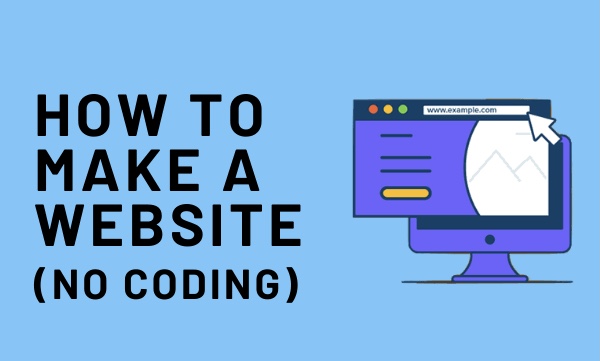
Master the Steps and Procedure to Make a Startup Website from Home in India
If you're planning to establish an online presence for your startup, creating a website from home in India is a cost-effective and convenient option. However, website creation can be a challenging task, especially if you're new to the process. But don't worry, we're here to help. In this article, we'll guide you through the steps and procedure to make a startup website from home in India.
Starting a home-based website can be an excellent way to venture into the online business world. By creating a website, you can reach out to your target audience, promote your products or services, and establish your brand's online presence in India. But before we dive into the steps, let's understand the importance of having a website for your startup.
Understand the Importance of a Website for Your Startup
Having a startup website is important for online business success in India. With an ever-increasing digital landscape, having a website is no longer an option but a necessity. It provides a platform to showcase your products and services, attract customers, and establish your brand's online presence.
Today, many consumers rely on the internet to find and evaluate businesses, making it imperative for startups to have a website to engage with potential customers. Your website serves as an extension of your brand and can impact your business's growth and profitability.
A startup website also offers several advantages, such as cost-effectiveness, wider reach, and the ability to operate 24/7. It allows you to connect with customers from all over India and even the world, providing an opportunity for scalability and expansion.
In summary, a startup website is an important component of any online business in India. Investing in a professional website will help you establish a great online presence, attract potential customers, and create long-term relationships with your audience.
Research and Identify Your Target Audience
Creating a startup website is an excellent way to establish an online presence for your business. However, before you begin building your website, it's necessary to identify your target audience to ensure your website resonates with them. Understanding your target audience will help you cater to their needs and preferences, ultimately leading to better engagement and increased conversions.
To begin with, you need to conduct thorough market research to determine your ideal customer base. You can start by creating customer personas that represent your typical customers. This involves researching demographic data such as age, gender, location, income, education, and occupation. You should also consider their interests, challenges, and pain points, as well as their online behavior and habits.
Once you have a clear understanding of your target audience, you can start creating content and designing your website that caters to their needs and preferences. Your website should provide value to your audience and solve their problems. This will help you establish trust and credibility, ultimately leading to better customer relationships.
Choose a Domain Name and Register It
Having a unique domain name that aligns with your brand is important for establishing a successful startup website. The domain name is the website's address, and it should reflect your business's identity and values. Here are the steps involved in choosing and registering a domain name for your website.
Think of potential domain names that represents your brand and values. Conduct thorough research to ensure the name is not already in use by another business.A short and easy-to-remember domain name is memorable and more likely to attract visitors to your website.Hyphens and numbers can confuse visitors and make your website appear unprofessional.
Choose an extension that aligns with your business's location and goals. For instance, .in is suitable for businesses operating in India.Once you have selected a suitable domain name, register it with a domain registrar. Many web hosting providers offer domain name registration services.Verify your domain name ownership to protect your brand and website from misuse.
By following these simple steps, you can select and register an appropriate domain name for your startup website in India. It is an essential step in the website creation process that can impact your online success.
Select a Web Hosting Provider
Choosing the right web hosting provider is important for your website's performance and user experience.Look for a provider that guarantees uptime and has a stable server. This ensures that your website will be accessible to visitors at all times. A fast server is essential for quick page loading times, which can impact user experience and search engine rankings.
As your website grows, you may need more resources to handle the traffic. Choose a provider that allows you to easily upgrade your hosting plan.Look for a provider with reliable customer support that is available 24/7. This ensures that any technical issues can be quickly resolved.
There are different types of web hosting available, including shared hosting, dedicated hosting, and VPS hosting. Consider your website's needs and choose the hosting option that best suits your requirements.Once you have selected a web hosting provider, you can proceed to the next step in the website creation process.
Plan Your Website's Structure and Content
Planning your website's structure and content is a basic step in the website creation process. A well-planned website that is easy to navigate can make a huge difference in user experience, resulting in increased engagement and conversions. Here are the steps to plan your website's structure and content.
Step 1: Define your goals and objectives
The first step is to define your goals and objectives for the website. You need to have a clear idea of what you want to achieve with your website and how it fits into your overall business strategy. Determine what actions you want visitors to take when they visit your website, and design your website to guide them towards these actions.
Step 2: Develop a sitemap
A sitemap is a visual representation of your website's structure. It helps you to organize your website's content and ensure that your website is easy to navigate. Create a clear and concise sitemap with all the pages you want to include on your website.
Step 3: Create wireframes
Wireframes are the blueprints of your website. They are a visual representation of the layout of your website's pages. Use wireframes to plan where your content will go on each page and to create a user-friendly page layout.
Step 4: Develop engaging content
Your website's content is what will keep visitors engaged and interested in your brand. Develop engaging and informative content that resonates with your target audience. Use relevant keywords and optimize your content for search engines to improve your website's visibility online.
By planning your website's structure and content before you start the design process, you can create a website that is user-friendly, engaging, and effective in achieving your business goals.
Design Your Website's Layout and Visuals
Designing an appealing website is important for attracting and getting visitors. The layout and visuals of your website can make or break the user experience. Therefore, it's essential to pay careful attention to the design elements when creating your startup website.
The first step in designing your website's layout is to create a wireframe. A wireframe is a simple schematic that outlines the placement of essential elements on each webpage. It helps you visualize the overall structure of your website and make necessary adjustments before moving onto the actual design.
When it comes to website design, simplicity is often the key. Avoid crowding your pages with unnecessary elements that distract from the main message. Use a consistent color scheme and font style to create a simple look and feel throughout the website.
Visuals play an important role in website design, and selecting the right images is essential.High-quality, relevant images can help your website stand out and convey your message effectively. Make sure the images are optimized for web use to avoid slow loading times.
Lastly, ensure that your website is mobile-friendly. With an increasing number of users accessing websites from their mobile devices, it's essential to optimize your website for mobile viewing. This includes using responsive design elements and ensuring the website is easily navigable on smaller screens.By carefully planning and designing your website's layout and visuals, you can create a visually appealing and user-friendly website that attracts and gets visitors.
Develop and Optimize Your Website's Content
Creating engaging and optimized content is the key to attracting and getting visitors on your startup website. As you develop your website content, it's essential to keep your target audience in mind and tailor your messaging to their needs and interests.
Start by conducting thorough keyword research to identify the terms and phrases your audience is using to search for products or services like yours. Use these keywords into your website content, including your headlines, body copy, and meta descriptions.
When writing your website copy, keep it concise, clear, and easy to read. Use short paragraphs, bullet points, and subheadings to break up large blocks of text and make your content more scannable. Additionally, use the active voice to make your messaging more compelling and engaging.
As you develop your content, pay close attention to your website's tone of voice and brand messaging. Your website copy should align with your brand values and convey a consistent message across all pages and sections.
Finally, optimize your website content for local search by including location-specific keywords and phrases. This will help your startup website show up in local search results and attract visitors in your target region.
Integrate Essential Features and Functionality
Integrating essential features and functionality is an important aspect of website development. Adding useful tools and plugins can enhance user experience and help your startup website stand out from the competition.When creating your website, consider using features such as contact forms, social media integration, and email signup forms to increase engagement and collect leads. Additionally, website builders provide a range of plugins and widgets that can add functionality to your website without requiring technical knowledge.
Ensure the essential features and functionality align with your website's goals and meet your target audience's needs. By selecting the right tools, you can create a highly functional website that can drive user satisfaction and conversions.
Test and Optimize Your Website
Testing your website's functionality and performance is important before launching it to the public. It is recommended to conduct thorough testing to identify and fix any issues that may negatively impact user experience.There are several aspects to test when it comes to website development. Firstly, ensure that all links and buttons are working correctly, and that there are no broken links.
Additionally, check the website's loading speed as slow loading times can lead to a high bounce rate.It is also important to test your website's compatibility across multiple devices and browsers. Make sure that your website is responsive and user-friendly on different screen sizes.
Once the testing phase is complete, optimize your website for the best possible performance. This includes optimizing images and videos to reduce loading time, implementing caching and compression techniques, and minimizing the use of unnecessary plugins or scripts.
Regular website maintenance is also important to keep your website running smoothly. Ensure that all software and plugins are up-to-date, and regularly check for any broken links or errors.Testing and optimizing your website is an ongoing process, and it is essential to keep monitoring and improving your website's performance over time.
Implement SEO Strategies for Online Visibility
Optimizing your startup website for search engines is crucial for driving organic traffic and reaching your target audience. Effective SEO strategies can improve your website's online visibility, increase brand awareness, and drive conversions. Here are some essential tips for implementing SEO on your website.
Identify keywords and phrases that your target audience is searching for and use them into your website's content, meta descriptions, and title tags.Ensure your website's on-page elements, including URL structure, headings, and alt tags, are optimized for search engines.
Develop high-quality and engaging content that aligns with your target audience's interests and needs.Build high-quality backlinks from reputable websites to improve your website's authority and search engine rankings.
Optimize your website's speed and ensure it's mobile-friendly to provide an excellent user experience and improve search engine rankings.Set up Google Analytics to track your website's performance and gain insights into your target audience's behavior and preferences.
By implementing these SEO strategies, you can improve your startup website's online visibility and drive organic traffic to your business. Remember to keep up with the latest SEO trends and best practices to stay ahead of the competition and achieve long-term success.
Implement Security Measures for Website Protection
As a startup website owner, your website's security should be a top priority. Cyber threats such as hacking and malware attacks can cause great damage to your online business. Implementing security measures for your website can prevent such attacks and safeguard your sensitive information and data.
One of the first steps you can take to secure your website is to install an SSL certificate. An SSL certificate encrypts the data exchanged between your website and visitors, making it difficult for hackers to steal sensitive information.Additionally, you can use security plugins to protect your website from malware and hacking attempts. These plugins can scan your website for vulnerabilities and offer real-time monitoring to detect any security threats.
Regularly updating your website's software and plugins is another essential security measure. Outdated software and plugins can have vulnerabilities that hackers can exploit to gain access to your website.You can also set up security protocols such as two-factor authentication to add an extra layer of security to your website login process.Implementing these security measures can help ensure your startup website is protected from cyber threats.
Establish Website Analytics and Tracking
Setting up website analytics and tracking is important for measuring your website's performance and making informed decisions to improve it. With analytics, you can monitor visitor behavior, track goals, and identify the sources of traffic.
Website analytics help you better understand your audience and tailor your website to their needs. By tracking metrics such as bounce rate, session duration, and conversion rate, you can identify areas for improvement and optimize your website for better results.
There are several website analytics tools available, including Google Analytics, Adobe Analytics, and Matomo. Choose the one that aligns with your needs and budget. After selecting your tool, set up an account, and add the tracking code to your website. Once the tracking code is added, your analytics tool will start recording data, which you can access and analyze.
Create Engaging Landing Pages and Call-to-Actions
Landing pages and call-to-actions (CTAs) are essential elements of a successful startup website. They provide a gateway for visitors to engage with your business and take desired actions, such as making a purchase or filling out a form.
When designing landing pages, it's important to consider the user experience and ensure that the content is relevant and engaging. Keep the design simple and visually appealing, with a clear headline that highlights the benefits of your product or service.
Make use of compelling imagery and use bullet points to break up lengthy paragraphs into easily digestible chunks. Emphasize your CTAs with bold colors and clear instructions, such as "Sign Up Now" or "Buy Now."
It's essential to A/B test your landing pages to determine what design and copy resonates best with your target audience. Use analytics tools to measure the performance of your landing pages and gather insights that can inform future optimization efforts.
Finally, ensure that your landing pages are optimized for mobile devices, as an increasing number of users access the internet on their phones. A responsive design that adapts to different screen sizes can significantly improve your website's engagement and conversion rates.
Conclusion
saborskill.com/contact
In conclusion, creating a startup website from home in India is a good option for entrepreneurs looking to establish an online presence. With the right steps and guidance, you can create a successful home-based website that caters to your target audience and meets your business objectives.
Remember, having a website is essential for any online business, and it's important to invest time and effort in planning, designing, and developing a website that reflects your brand image. By following the steps outlined in this guide, you can create an optimized, user-friendly, and secure website that drives traffic, increases conversions, and enhances customer engagement.
Whether you're a small business owner or an aspiring entrepreneur, creating a startup website from home in India offers many benefits. With the right tools, resources, and strategies, you can use power of the internet to grow your business, establish credibility, and reach a global audience. So, what are you waiting for? Start your website creation journey today and take the first step towards building a successful online business in India.
Subscribe to get latest courses on your email.
Subscribe now for an exclusive 20% discount on every course. Don't miss out on this fantastic offer!






